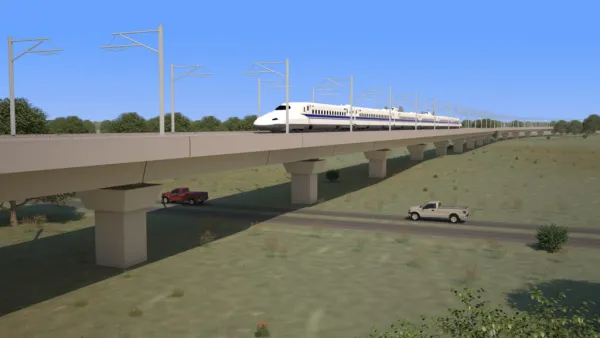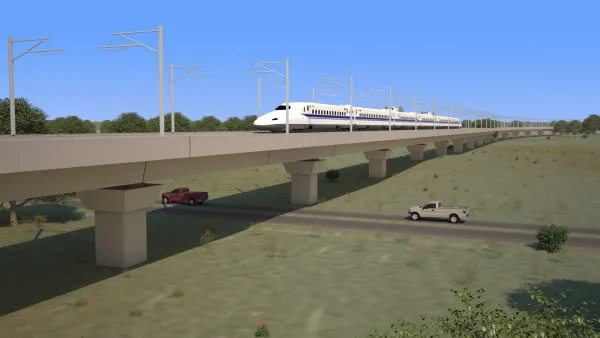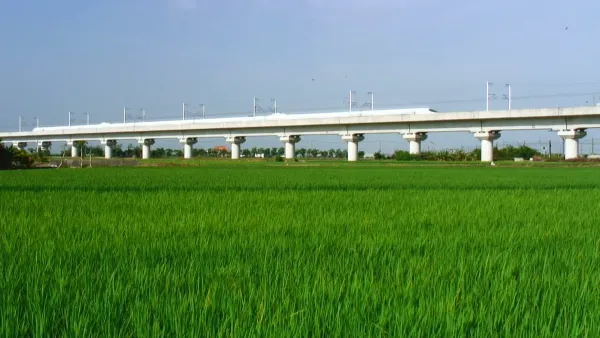Parts of rural Texas sound a bit like the outspoken high speed rail opponents in California's Central Valley in their reaction to the Texas Central Railway's bullet train which maintains strong support at the terminal cities of Houston and Dallas.
The Federal Railroad Administration (FRA) has begun holding public scoping meetings on the Texas Central Railway, the nation's second (after California's that began earlier) true, all-electric high speed rail train but is scheduled to be the first to begin operations in 2021. Unlike the San Francisco to Los Angeles bullet train, the Texas train will be privately funded.
Aman Batheja of The Texas Tribune ventures into the Texas countryside, the rural areas between the bookends of Dallas and Houston where the 90-minute ride is largely welcomed as a safer, more relaxed alternative to a four-hour drive.
Unlike the big cities, where the mayors of Dallas, Fort Worth and Houston announced support for the the train in March, "the reception has been less rosy from rural communities that will be on or near a possible train route," writes Batheja. "Officials and residents have expressed concern about the noise from trains whizzing past their quiet towns dozens of times a day and about a track dividing farmland and reducing property values."
I haven't heard anything positive about it whatsoever,” said Byron Ryder, the county judge in Leon County, which is about halfway between Dallas and Houston. “I’ve talked to other judges and commissioners up and down the line, landowners up and down the line. No one wants it.”
Not speaking positive about the bullet train is one thing; getting litigious like the Kings County (Central Valley), Calif. supervisors, et.al is quite another.
At the first meeting held Oct 21 in Dallas, train plans "drew unanimous support for the multibillion-dollar project, but also repeated warnings from residents and local officials that the locations of the stations are vital," wrote Batheja then.
Determining the route is one of the issues that are part of the FRA’s draft environmental impact study (EIS), yet to be posted on the website. "The railroad administration looked at nine potential routes, but has narrowed its focus to two that appear to be least disruptive," writes Batheja who goes on to describe them.
More than 100 miles of the 240-mile corridor would be built on elevated tracks to reduce the impact on communities, said Travis Kelly, Texas Central Railway’s vice president for government relations. He added that the company’s goal was to “use existing rights of way as much as possible in order to minimize the need for access to land.”
Batheja ended on an upbeat note in Grimes County where farmers are concerned that their property could be divided by the tracks and homeowners worried about reduced property values.
"One factor that would weigh heavily, said Betty Shiflett, the county judge, was whether Texas Central Railway followed through on plans to build a station in Grimes County to allow the bullet train to serve nearby College Station, the home of Texas A&M University," he writes.
“I think people would be a lot more enthusiastic because they would probably take it,” Ms. Shiflett said. “I know I would, definitely.”
I doubt you'd hear anything like that from Central Valley, Calif. rail critics.
The FRA scoping meetings appear to be separate from meetings held by TxDOT in the Dallas-Fort Worth region described by the The Dallas Morning News transportation writer Brandon Formby.
The New York Times article is also available in The Texas Tribune.
[Hat tip to Streetsblog's Katie Pearce]
FULL STORY: Both Ends Want Bullet Train; It’s Those in Middle Who Object

Analysis: Cybertruck Fatality Rate Far Exceeds That of Ford Pinto
The Tesla Cybertruck was recalled seven times last year.

National Parks Layoffs Will Cause Communities to Lose Billions
Thousands of essential park workers were laid off this week, just before the busy spring break season.

Retro-silient?: America’s First “Eco-burb,” The Woodlands Turns 50
A master-planned community north of Houston offers lessons on green infrastructure and resilient design, but falls short of its founder’s lofty affordability and walkability goals.

Test News Post 1
This is a summary

Analysis: Cybertruck Fatality Rate Far Exceeds That of Ford Pinto
The Tesla Cybertruck was recalled seven times last year.

Test News Headline 46
Test for the image on the front page.
Urban Design for Planners 1: Software Tools
This six-course series explores essential urban design concepts using open source software and equips planners with the tools they need to participate fully in the urban design process.
Planning for Universal Design
Learn the tools for implementing Universal Design in planning regulations.
EMC Planning Group, Inc.
Planetizen
Planetizen
Mpact (formerly Rail~Volution)
Great Falls Development Authority, Inc.
HUDs Office of Policy Development and Research
NYU Wagner Graduate School of Public Service




























